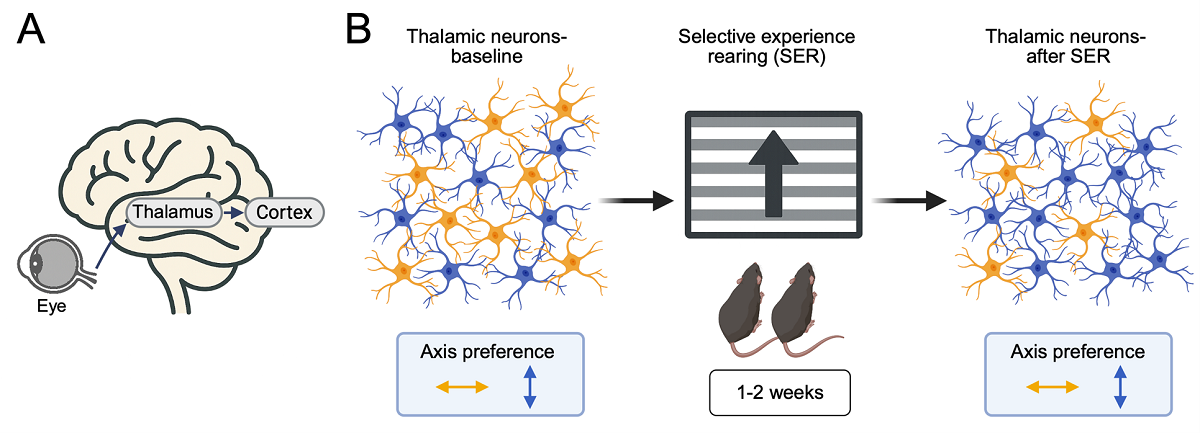By Takuma Sonoda
Our brains are continuously processing a wealth of visual information — from light and color to motion and shape. But how does the brain decide what matters and what to ignore? It turns out that individual neurons can recognize specific features in the environment, such as the size or direction of a moving object. Moreover, neurons can change what features they care about based on experience, a phenomenon called experience-dependent plasticity that is critical to study both for understanding healthy brain development and a variety of neurodevelopmental disorders. For years, scientists believed that experience-dependent plasticity primarily occurred in the cortex, which is the outermost part of the brain, responsible for higher processing. Earlier stages of sensory processing, like the visual thalamus, were thought to simply relay information from the eyes to the cortex.
In this study—conducted in collaboration with the labs of Michael E. Greenberg and Michela Fagiolini, as part of the Tan-Yang Center for Autism Research at Harvard’s efforts to better understand neurodevelopmental processes that may be altered in autism–we set out to ask, can the visual thalamus also change in response to sensory experience? To test this, we raised young mice in a special environment where they saw only one kind of visual stimulus: horizontal stripes moving upward. This setup, called selective experience rearing, lasted between one to two weeks while the mice were still developing.
In control mice raised in a normal environment, equal numbers of neurons in the visual thalamus respond horizontal or vertical motion. But after selective experience rearing, we found that more neurons preferred vertical motion—the direction matching the repeated visual input. This result was surprising because it meant that the thalamus is not just passively relaying signals. It is actively reshaping what information is sent to the cortex.
To figure out what connections in the thalamus caused these changes, we first temporarily silenced the cortex. If the change came from cortical feedback, silencing the cortex should abolish the effect. But the bias toward vertical motion remained even after silencing the cortex. This indicated that the plasticity is not inherited from the cortex. We also worked with mutant mice that had disrupted connections between the eye and the thalamus. In these mice, selective experience rearing did not produce the same changes, suggesting that a properly wired input from the retina is necessary for this kind of plasticity.
Effects of selective experience rearing on thalamic neuron properties
(A) Schematic of the primary visual pathway responsible for mediating visual perception. Retinal neurons send information to the visual thalamus, which integrates these signals and sends them to visual cortex.
(B) Under normal rearing conditions, equal numbers of neurons exhibit a preference for vertical (blue) and horizontal motion (yellow). After 1-2 weeks of selective experience rearing, more thalamic neurons prefer vertical motion.

Effects of selective experience rearing on thalamic neuron properties
(A) Schematic of the primary visual pathway responsible for mediating visual perception. Retinal neurons send information to the visual thalamus, which integrates these signals and sends them to visual cortex.
(B) Under normal rearing conditions, equal numbers of neurons exhibit a preference for vertical (blue) and horizontal motion (yellow). After 1-2 weeks of selective experience rearing, more thalamic neurons prefer vertical motion.
When we repeated the experiments in adult animals, we found that while adults also exhibited plasticity, the effects were temporary. In contrast, the changes we saw in young mice were more stable and long-lasting. This highlights a key difference in how the brain learns at different ages and suggests a “critical period” for long-lasting changes in the thalamus.
Taken together, our findings show that the thalamus is more than just a relay station. It can actively refine what visual information gets passed along to the cortex, and this refinement depends on what the animal sees. This discovery expands our understanding of how sensory systems learn and adapt. It may also open new doors for harnessing this plasticity to design therapies for visual processing disorders and neurodevelopmental conditions.
Takuma Sonoda is Postdoctoral Fellow in Chinfei Chen’s lab in the F.M. Kirby Center for Neurobiology at Boston Children’s Hospital
Learn more in the original research article:
Experience influences the refinement of feature selectivity in the mouse primary visual thalamus.
Sonoda T, Stephany CÉ, Kelley K, Kang D, Wu R, Uzgare MR, Fagiolini M, Greenberg ME, Chen C. Neuron. 2025 May 7;113(9):1352-1362.e4. doi: 10.1016/j.neuron.2025.02.023. Epub 2025 Mar 19.
News Types: Community Stories
